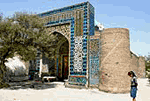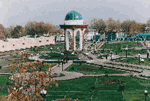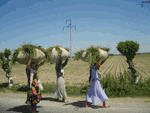Introduction
 Margilan (Uzbek: Margilon) or Margelan is a city (1999 population 143,600) in Fergana Province in eastern Uzbekistan. It is located at latitude 40°28′ 16 N, longitude 71°43′ 29 E at an altitude of 487 meters.
Margilan (Uzbek: Margilon) or Margelan is a city (1999 population 143,600) in Fergana Province in eastern Uzbekistan. It is located at latitude 40°28′ 16 N, longitude 71°43′ 29 E at an altitude of 487 meters.
Margilan, one of the ancient cities in the world, by the decision of UNESCO will celebrate its 2000th anniversary in 2009.
According to European legend, Margilan was founded by Alexander the Great. On a lunch stop, he was given chicken (murgh in Persian) and bread (nan in Persian), from which the town took its name.
More reliable records indicate that Margilan was an important stop on the Silk Road by the 9th century AD, along the route going across the Alay Mountains (ancient Mount Imeon) to Kashgar.
First time Margilan was mentioned in chronicles in 7th century. In 10th century, it was already a centre of agricultural neighborhood.

Development of agriculture and crafts as well as growth of city promoted the revival of international trading.
Locating in south-east of Fergana Valley, Margilan is considered to be one of the ancient cities in Uzbekistan and Central Asia, as well as a big centre of international trade. The caravan routes connected Europe with the East Asia via Margilan.

The beautiful silk fabric and the pedigreed horses have been the main goods on this route. From time immemorial, population of Margilan was busy with manufacturing beautiful silk fabrics making thus Margilan city well-known all over the world. Skilled craftsmen obtained the fine threads of the silkworm cocoons for manufacturing marvelous silk fabrics that have been in great demand in Euro-Asian countries.
Writing in the early 16th century, the founder of the Mughal dynasty, Babur, mentioned that:
This reputation for toughness extends to modern times.

Margilan merchants were key players in Central Asian commerce, and were said to be a law unto themselves during Soviet days, when Margilan was the heart of Uzbekistan’s black market. Margilan today is also a stronghold of conservative Islam.
Syuzane (large-sized silk embroidery) and skullcaps (the national headdress), as well as silver and gold articles are the best samples of Margilan traditional cultures reached our days
